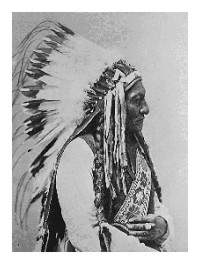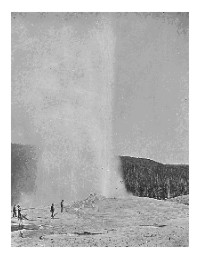Sponsor this page. Your banner or text ad can fill the space above.
Click here to Sponsor the page and how to reserve your ad.
-
Timeline
1873 - Detail
July 21, 1873 - Jesse James and the James-Younger Gang engage in the first successful train robbery in the American West, taking three thousand dollars from the Rock Island Express at Adair, Iowa.

He had been a Confederate soldier with Quantrill's raiders, then Clement's guerrillas, and now, after July 21, 1873, Jesse James, his brother Frank, and the rest of the James-Younger gang would be train robbers.
They had been busy since the end of the Civil War. One month after Lee's surrender at Appomattox in April 1865, the guerrillas under Little Arch Clements were still ravaging the Missouri towns of Holden and Kingsville, but the Union soldiers were closing in on Confederate stragglers. Jesse James tried to surrender, but was shot and severely injured, before escaping. Once healed, by 1866, Jesse James and the Younger brothers were no longer interested in surrender or pardons, they were planning bank robberies. On February 13, 1866, the James Younger gang robbed the Liberty, Missouri bank under Jesse's direction, but without his participation. He was still recovering.
Over the next seven years, the James Younger gang would rob seven banks and businesses with a variety of members in the states of Iowa, Kentucky, and Missouri. After a successful bank robbery on May 27, 1873 at the Ste. Genevieve Savings Bank in Ste. Genevieve, Missouri, the gang turned their attention to robbing a train. They had learned that $75,000 in gold from Cheyenne would be transported on the newly built main line of the Chicago, Rock Island, and Pacific Railroad. Additional gang members joined around this time, including Jim and Bob Younger, Charlie Pitts, and Bill Chadwell.
On July 21, 1873, an estimated seven to nine members of the Jesse James and Younger Brothers gang robbed the Chicago, Rock Island, and Pacific Railroad. It was night and would be the first attempt at stopping and robbing a moving train. That's a bit of a distinction we'll touch on later.
Frank James and Cole Younger had been sent to Omaha to ascertain the schedule for the shipment as Jesse James, Jim and Tom Younger, Clell Miller, and Bill Chadwell, remained in camp near Adair. Once knowledge of the schedule was gained, the gang stole a spike-bar and hammer, and pried loose two spikes around a curve near Turkey Creek one and one half miles west of Adair. They hid beneath the bank and waited for the train to approach.
Although it was not planned, they derailed the train, toppling it into the creek, killing the engineer, John Rafferty, the fireman, Dennis Foley, who died of his wounds, and wounding a number of passengers. As an act of defiance against President Ulysses S. Grant's use of the Enforcement Acts to quell activities of the Klu Klux Klan, the gang wore Klan masks.
Legend states that Jesse and Frank James climbed into the express car, and forced the guard to open the safe, but only $2,000 remained. The gold shipment had been delayed. Stealing that, and $1,000 from the passengers, the James and Younger gang had successfully, for the first time, stopped and robbed a moving train. When word spread by telegraph across Iowa and the nation of the escapade, armed men were sent from Council Bluffs to track the outlaws. Jesse and the gang split up once reaching Missouri, escaping into the prairie, forests, and towns. The governor offered a $10,000 reward for capture.
Jesse James, Frank James, and the Civil War
Frank James was four years older than Jesse, born in 1843, eighteen years old when he joined the Missouri Home Guard on May 4, 1861, just after the outbreak of the Civil War. He fought in the Battle of Wilson's Creek on August 10, 1861 with Drew Lobbs Army. By May of 1863, Frank had joined Quantrill's raiders. Soon after, Union soldiers approached his mother Zerelda, roughing her and younger son Jesse up, and also hanged her husband Rueben Samuel, but do not kill him. They wanted to know the location of Quantrill's raiders.
By winter of that year, Quantrill's guerrillas, destroyed Lawrence, Kansas, killing one hundred and eighty three, and Jesse James, incessed over the actions against his family, joined the fray in the spring of 1864 with Fletch Taylor. Both Frank and Jesse James enlist in Bloody Bill Anderson's offshoot of Quantrill that year. Jesse participates in the Centralia raid in September 1864, where twenty-five Union soldiers are killed, as well as a pursuing party of over one hundred under Major A.V.E. Johnston, who was shot, reportedly by Jesse James. In October, Frank and Jesse split up. Jesse joined the gang of Little Arch Clements; Frank followed Quantrill into Kentucky.

Was It Actually the First
There is some disagreement on whether the Adair train robbery was the first in history of a moving train. Some segment the category into peacetime and war, as one particular attempt was made during the aftermath of the Civil War in May 1865. That attempt, however, is stated to have been while the train was at rest. For some, the first peacetime moving train robbery occurred on October 6, 1866, by the Reno Gang of an Ohio and Mississippi train. The robbers reportedly boarded the train at the Seymour, Indiana depot, rode several miles east, and robbed two safes. They signalled the engineer to stop the train and jumped off with twelve thousand dollars.
The fact that the 1866 Reno gang robbery did not technically involve boarding or toppling a moving train, may distinguish it from the later James and Younger gang robbery at Adair. In either case, both train robberies were new forms of theft for the American public. The Reno brothers; Frank, John, Simeon, and William were residents of Rockford, Indiana, two miles north of Seymour.
Photo above: Guns and equipment of Jesse James and associates, 1921. Courtesy Library of Congress. Photo below: Lithograph from W.I. Swain's Production, Jesse James, circa 1880's, Donaldson Lithograph Company. Courtesy Library of Congress. Info Source: A Timeline of Events in the History of the James-Younger Gang; Jesse James Historic Site, Adair; Wikipedia Commons; Roadtrippers.com; Legendsofamerica.com.




